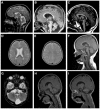A novel cerebello-ocular syndrome with abnormal glycosylation due to abnormalities in dolichol metabolism
- PMID: 20852264
- PMCID: PMC6276930
- DOI: 10.1093/brain/awq261
A novel cerebello-ocular syndrome with abnormal glycosylation due to abnormalities in dolichol metabolism
Abstract
Cerebellar hypoplasia and slowly progressive ophthalmological symptoms are common features in patients with congenital disorders of glycosylation type I. In a group of patients with congenital disorders of glycosylation type I with unknown aetiology, we have previously described a distinct phenotype with severe, early visual impairment and variable eye malformations, including optic nerve hypoplasia, retinal coloboma, congenital cataract and glaucoma. Some of the symptoms overlapped with the phenotype in other congenital disorders of glycosylation type I subtypes, such as vermis hypoplasia, anaemia, ichtyosiform dermatitis, liver dysfunction and coagulation abnormalities. We recently identified pathogenic mutations in the SRD5A3 gene, encoding steroid 5α-reductase type 3, in a group of patients who presented with this particular phenotype and a common metabolic pattern. Here, we report on the clinical, genetic and metabolic features of 12 patients from nine families with cerebellar ataxia and congenital eye malformations diagnosed with SRD5A3-congenital disorders of glycosylation due to steroid 5α-reductase type 3 defect. This enzyme is necessary for the reduction of polyprenol to dolichol, the lipid anchor for N-glycosylation in the endoplasmic reticulum. Dolichol synthesis is an essential metabolic step in protein glycosylation. The current defect leads to a severely abnormal glycosylation state already in the early phase of the N-glycan biosynthesis pathway in the endoplasmic reticulum. We detected high expression of SRD5A3 in foetal brain tissue, especially in the cerebellum, consistent with the finding of the congenital cerebellar malformations. Based on the overlapping clinical, biochemical and genetic data in this large group of patients with congenital disorders of glycosylation, we define a novel syndrome of cerebellar ataxia associated with congenital eye malformations due to a defect in dolichol metabolism.
Figures




Similar articles
-
Life with too much polyprenol: polyprenol reductase deficiency.Mol Genet Metab. 2012 Apr;105(4):642-51. doi: 10.1016/j.ymgme.2011.12.017. Epub 2011 Dec 29. Mol Genet Metab. 2012. PMID: 22304929 Free PMC article.
-
SRD5A3-CDG: Expanding the phenotype of a congenital disorder of glycosylation with emphasis on adult onset features.Am J Med Genet A. 2016 Dec;170(12):3165-3171. doi: 10.1002/ajmg.a.37875. Epub 2016 Aug 2. Am J Med Genet A. 2016. PMID: 27480077 Free PMC article.
-
SRD5A3-CDG: a patient with a novel mutation.Eur J Paediatr Neurol. 2012 Sep;16(5):554-6. doi: 10.1016/j.ejpn.2011.12.011. Epub 2012 Jan 10. Eur J Paediatr Neurol. 2012. PMID: 22240719
-
Review of SRD5A3 Disease-Causing Sequence Variants and Ocular Findings in Steroid 5α-Reductase Type 3 Congenital Disorder of Glycosylation, and a Detailed New Case.Folia Biol (Praha). 2019;65(3):134-141. doi: 10.14712/fb2019065030134. Folia Biol (Praha). 2019. PMID: 31638560 Review.
-
SRD5A3-CDG: A Patient with a Novel Variant and Brain Neoplasm.J Coll Physicians Surg Pak. 2022 Dec;32(12):SS221-SS226. doi: 10.29271/jcpsp.2022.Supp0.SS221. J Coll Physicians Surg Pak. 2022. PMID: 36597345 Review.
Cited by
-
Mouse models for congenital disorders of glycosylation.J Inherit Metab Dis. 2011 Aug;34(4):879-89. doi: 10.1007/s10545-011-9295-7. Epub 2011 Feb 24. J Inherit Metab Dis. 2011. PMID: 21347588 Review.
-
Overexpression of SRD5A3 in Hepatocellular Carcinoma and Its Molecular Mechanism: A Study of Bioinformatics Exploration Analysis with Experimental Verification.Evid Based Complement Alternat Med. 2022 Sep 16;2022:7853168. doi: 10.1155/2022/7853168. eCollection 2022. Evid Based Complement Alternat Med. 2022. PMID: 36159555 Free PMC article.
-
Neurology of inherited glycosylation disorders.Lancet Neurol. 2012 May;11(5):453-66. doi: 10.1016/S1474-4422(12)70040-6. Lancet Neurol. 2012. PMID: 22516080 Free PMC article.
-
Life with too much polyprenol: polyprenol reductase deficiency.Mol Genet Metab. 2012 Apr;105(4):642-51. doi: 10.1016/j.ymgme.2011.12.017. Epub 2011 Dec 29. Mol Genet Metab. 2012. PMID: 22304929 Free PMC article.
-
A mutation in mannose-phosphate-dolichol utilization defect 1 reveals clinical symptoms of congenital disorders of glycosylation type I and dystroglycanopathy.JIMD Rep. 2019 Sep 30;50(1):31-39. doi: 10.1002/jmd2.12060. eCollection 2019 Nov. JIMD Rep. 2019. PMID: 31741824 Free PMC article.
References
-
- Al-Gazali L, Hertecant J, Algawi K, El Teraifi H, Dattani M. A new autosomal recessive syndrome of ocular colobomas, ichthyosis, brain malformations and endocrine abnormalities in an inbred Emirati family. Am J Med Genet A. 2008;146:813–9. - PubMed
-
- Assmann B, Hackler R, Peters V, Schaefer JR, Arndt T, Mayatepek E, et al. A new subtype of a congenital disorder of glycosylation (CDG) with mild clinical manifestations. Neuropediatrics. 2001;32:313–8. - PubMed
-
- Babovic-Vuksanovic D, O'Brien JF. Laboratory diagnosis of congenital disorders of glycosylation type I by analysis of transferrin glycoforms. Mol Diagn Ther. 2007;11:303–11. - PubMed
-
- Bickel T, Lehle L, Schwarz M, Aebi M, Jakob CA. Biosynthesis of lipid-linked oligosaccharides in Saccharomyces cerevisiae: ALG13p and ALG14p form a complex required for the formation of GlcNAc2-PP-Dol. J Biol Chem. 2005;280:34500–6. - PubMed
-
- Brownstein MJ, Carpten JD, Smith JR. Modulation of non-templated nucleotide addition by Taq DNA polymerase: primer modifications that facilitate genotyping. Biotechniques. 1996;20:1004–10. - PubMed
Publication types
MeSH terms
Substances
Grants and funding
LinkOut - more resources
Full Text Sources
Medical
Molecular Biology Databases

